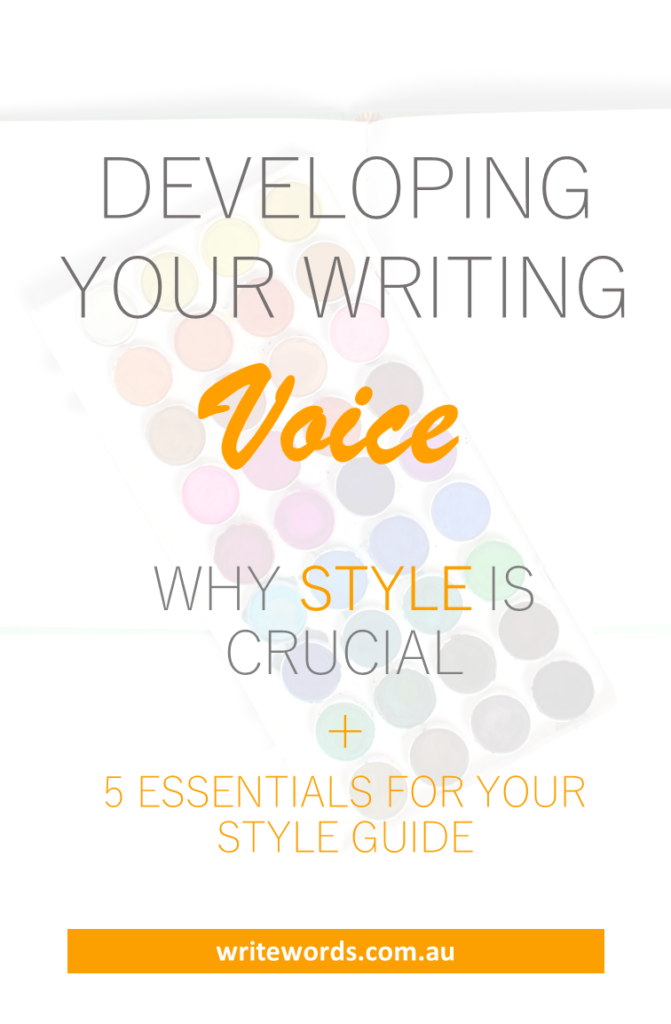Why your style is so important for your writing strategy – and how to develop it
The next time you’re reflecting on your writing strategy, print some samples of your own writing and compare the style and presentation.
Are they consistent? How do they differ?
- What’s the level of formality?
- Are some conversational, and others a little more abrupt?
- Is the language – the words you’ve used – similar across different modes of communication?
Ideally it will have a familiar feel.
That’s because consistency across all of your communication – written and otherwise – is essential for a coherent and credible brand.

What’s your brand?
Whether you’re a solopreneur, one of many people who write for your organisation or the only one who writes (emails, web content, newsletters, blogs, social media), you’re writing for a brand.
Your brand is what distinguishes you or your organisation from others. Essentially, it’s a reflection of your (or your organisation’s) personality. Brand elements include the name, visuals (logo, colours, design – think the Nike ‘swoosh’), voice (written communication) and reputation.
Do you write too many words?
Cut the clutter with this cheat sheet.
And all of these need to feel the same across different media, over time.
So how do you keep your writing consistent across all of your communications channels?
Your style guide
A style guide ensures the same voice is conveyed each time something is written – whether you’re the only one or one of many on the team.
If you don’t have one yet, here’s a guide on how to develop your own writing style and a style guide.
Getting started
A style guide need only be a Word document or PDF to be used as a reference by anyone who writes for the brand.
Once you’ve established a style, you can go to the next level and develop a system of templates to ensure every piece of communication maintains similar structure and presentation.
But let’s start with the style guide.
5 essential ingredients that will shape your style
1. Your voice
Tone
Your tone should be determined by your reader.
Not only does each reader or group of readers have different needs, they also communicate differently.
You want to appeal to your target reader.
So consider whether your audience is young and hip, if they’d prefer something more formal, humorous or fast-paced. Maybe they need a persuasive edge.
A conversational tone can help put your reader at ease. It makes it easier to forge a relationship and keep them engaged. This doesn’t mean you need to write like you speak. But you do need to sound like you (or your brand).
Language
Your reader also determines the language or words you use. Will they understand your terminology, abbreviations, jargon? And which words should you avoid – or use more of?
Engaging your reader
How else can you engage your reader?
- Concise, punchy sentences.
- Emotion.
- Rhythm.
- A clear call-to-action.
- Questions just like the one before this answer.
Do all of this consistently, and it builds your voice. Your style.
Write with more confidence with 3 simple tricks.
WATCH NOW!
2. Spelling, punctuation, numbers
Spelling
Select a dictionary of choice for your brand, for example, the Australian Macquarie Dictionary. This avoids confusion for words that us Aussies spell differently to other parts of the world:
- Adviser and advisor
- Email and e-mail
- Enquiry and inquiry
- Focused and focussed
- Organise and organize
- Programme and program
- Travelled and traveled
- Verandah and veranda
Punctuation
Of course, you need to get punctuation marks in the right place, but the frequency of commas, semicolons, full stops can be a matter of preference.
Remember, though, simplicity – short sentences and short paragraphs – is one way to make your message powerful and compelling.
Once you’ve determined how long you like your sentences and when you prefer to pause, include this in your style guide. Here’s some help with some of the most misused punctuation marks.
Numbers
Commonly, written style is to write one to nine in words and 10 and beyond in numerals. Are your writers aware of this?
3. Presentation & readability
Most readers have only the time to scan or your email, blog post, report, website. Give your reader big chunks of text, and they’ll probably turn to something else competing for their time.
So keep the presentation of your writing reader-friendly.
Do you prefer bullet points to break up text on a page? If so, which style of bullet looks best? Use the same ones each time.
Will you use UPPERCASE or Title Case for your headings? And what about your sub-headings? Simply bold? Which font do you prefer, and what size? Use the same ones each time.
4. Structure
Do – or should – your documents follow a certain structure? For example, does more than one person within your organisation write proposals for the same client?
No matter the level of communication, it should always have a similar presentation – one that is familiar and a true representation of your brand (visual and written).
5. Formatting
Generally, underline is rarely used, italics are used for names such as books or boats, and bold is for emphasis. However, you may have noticed, I like italics for emphasis. What ‘rules’ suit your business communication? Let me know in the comments section below.
Once you’ve established your preferred formatting style, document it in your style guide so everyone else who writes for your brand can adopt the same presentation.
Extras
- Reader background may be useful if you have reader sub-groups. Refamiliarise yourself with the audience’s preferences each time you write.
- If writing succinctly isn’t a strength, you may like to include some tips in your style guide to reduce wordiness.
- Proofreading is essential before sending out any piece of communication, no matter how long it is, so include some tips on making this process effective, too.
What will you include in your style guide? Let us know, below!
Want to produce better writing?
Join the WriteWell community and receive valuable resources that will improve your writing, including tips, cheat sheets and more. Here’s a taster:
- Write less, say more: Make more impact by writing fewer words
- Write with purpose: 5 ways to strategically target your reader
- Captivate your readers: How to write compelling content
- The power of simplicity: How to keep even the most complex writing task simple
Receive more writing tips – free into your inbox. Sign me up!
Share the love!
Like this writing tip? Share it with your friends and colleagues.


